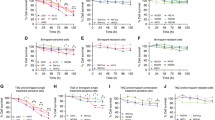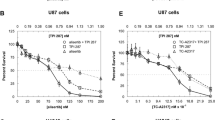Abstract
Glioblastoma multiforme (GBM) is a brain tumour characterised by a remarkably high chemoresistance and infiltrating capability. To date, chemotherapy with temozolomide has contributed only poorly to improved survival rates in patients. One of the most important mechanisms of chemoresistance comes about through the activity of certain proteins from the ATP-binding cassette superfamily that extrudes antitumour drugs, or their metabolites, from cells. We identify an increased expression of the multiple drug resistance-associated protein 1 (Mrp1) in glioblastoma multiforme biopsies and in T98G and G44 cell lines. The activity of this transporter was also confirmed by measuring the extrusion of the fluorescent substrate CFDA. The sensitivity of GBM cells was low upon exposure to temozolomide, vincristine and etoposide, with decreases in cell viability of below 20% seen at therapeutic concentrations of these drugs. However, combined exposure to vincristine or etoposide with an inhibitor of Mrp1 efficiently decreased cell viability by up to 80%. We conclude that chemosensitization of cells with inhibitors of Mrp1 activity might be an efficient tool for the treatment of human GBM.




Similar content being viewed by others
References
Sharom FJ (2008) ABC multidrug transporters: structure, function and role in chemoresistance. Pharmacogenomics 9:105–127
Ozben T (2006) Mechanisms and strategies to overcome multiple drug resistance in cancer. FEBS Lett 580:2903–2909
Thomas H, Coley HM (2003) Overcoming multidrug resistance in cancer: an update on the clinical strategy of inhibiting p-glycoprotein. Cancer Control 10:159–165
Gottesman MM, Fojo T, Bates SE (2002) Multidrug resistance in cancer: role of ATP-dependent transporters. Nat Rev Cancer 2:48–58
Awasthi S, Singhal S, Singhal J et al (2007) Role of RLIP76 in lung cancer doxorubicin resistance: III. Anti-RLIP76 antibodies trigger apoptosis in lung cancer cells and synergistically increase doxorubicin cytotoxicity. Int J Oncol 22:721–732
Steiner E, Holzmann K, Elbling L et al (2006) Cellular functions of vaults and their involvement in multidrug resistance. Curr Drug Targets 7:923
Paredes A, Blanco JL, Echenique-Elizondo M (2006) Expression of multidrug resistance (MDR) associated proteins in solid tumors. Cir Esp 79:202–214
Choi CH (2005) ABC transporters as multidrug resistance mechanisms and the development of chemosensitizers for their reversal. Cancer Cell Int 5:30
Ahmedin J, Siegel R, Xu J et al (2010) Cancer statistics, 2010. CA Cancer J Clin 65:277–300
Chang SM, Butowski NA, Sneed PK et al (2006) Standard treatment and experimental targeted drug therapy for recurrent glioblastoma multiforme. Neurosurg Focus 20:E4
Stupp R, van den Bent MJ, Hegi ME (2005) Optimal role of temozolomide in the treatment of malignant gliomas. Curr Neurol Neurosci Rep 5:198–206
Loscher W, Potschka H (2005) Drug resistance in brain diseases and the role of drug efflux transporters. Nat Rev Neurosci 6:591–602
Yuan H, Li X, Wu J et al (2008) Strategies to overcome or circumvent P-glycoprotein mediated multidrug resistance. Curr Med Chem 15:470–476
Hennessy M, Spiers JP (2007) A primer on the mechanics of P-glycoprotein the multidrug transporter. Pharmacol Res 55:1–15
Mizutani T, Hattori A (2005) New horizon of MDR1 (P-glycoprotein) study. Drug Metab Rev 37:489–510
Mealey KL (2004) Therapeutic implications of the MDR-1 gene. J Vet Pharmacol Ther 27:257–264
Liscovitch M, Lavie Y (2002) Cancer multidrug resistance: a review of recent drug discovery research. IDrugs 5:349–355
Benyahia B, Huguet S, Declèves X et al (2004) Multidrug resistance-associated protein MRP1 expression in human gliomas: chemosensitization to vincristine and etoposide by indomethacin in human glioma cell lines overexpressing MRP1. J Neuro-oncol 66:65–70
Calatozzolo C, Gelati M, Ciusani E et al (2005) Expression of drug resistance proteins Pgp, MRP1, MRP3, MRP5 and GST-pi in human glioma. J Neuro-oncol 74:113–121
Decléves X, Amiel A, Delattre JY et al (2006) Role of ABC transporters in the chemoresistance of human gliomas. Curr Cancer Drug Targets 6:433–445
Matsumoto Y, Miyake K, Kunishio K et al (2004) Reduction of expression of the multidrug resistance protein (MRP)1 in glioma cells by antisense phosphorothioate oligonucleotides. J Med Invest 51:194–201
Decléves X, Fajac A, Lehmann-Che J et al (2002) Molecular and functional MDR1-Pgp and MRPs expression in human glioblastoma multiforme cell lines. Int J Cancer 98:173–180
Zhang W, Mojsilovic-Petrovic J, Andrade MF et al (2003) The expression and functional characterization of ABCG2 in brain endothelial cells and vessels. FASEB J 17:2085–2087
Quezada CA, Garrido WX, González-Oyarzún MA et al (2008) Effect of tacrolimus on activity and expression of P-glycoprotein and ATP-binding cassette transporter A5 (ABCA5) proteins in hematoencephalic barrier cells. Biol Pharm Bull 31:1911–1916
Echevarria-Lima J, Kyle-Cezar F, Leite DFP et al (2005) Expression and activity of multidrug resistance protein 1 in a murine thymoma cell line. Immunology 114:468–475
Hammond CL, Marchan R, Krance SM et al (2007) Glutathione export during apoptosis requires functional multidrug resistance-associated proteins. J Biol Chem 282:14337–14347
Dogan AL, Legrand O, Faussat AM et al (2004) Evaluation and comparison of MRP1 activity with three fluorescent dyes and three modulators in leukemic cell lines. Leuk Res 28:619–622
Gekeler V, Ise W, Sanders KH et al (1995) The leukotriene LTD4 receptor antagonist MK571 specifically modulates MRP associated multidrug resistance. Biochem Biophys Res Commun 208:345–352
Abe T, Mori T, Wakabayashi Y, Nakagawa M et al (1998) Expression of multidrug resistance protein gene in patients with glioma after chemotherapy. J Neuro-oncol 40:11–18
Bredel M, Zentner J (2002) Brain-tumour drug resistance: the bare essentials. Lancet Oncol 3:397–406
Patel M, McCully C, Godwin K et al (2003) Plasma and cerebrospinal fluid pharmacokinetics of intravenous temozolomide in non-human primates. J Neuro-oncol 61:203–207
Ostermann S, Csajka C, Buclin T et al (2004) Plasma and cerebrospinal fluid population pharmacokinetics of temozolomide in malignant glioma patients. Clin Cancer Res 10:3728–3736
Chang JE, Robins HI, Mehta MP (2007) Therapeutic advances in the treatment of brain metastases. Clin Adv Hematol Oncol 5:54–64
Hegi ME, Liu L, Herman JG et al (2008) Correlation of O6-methylguanine methyltransferase (MGMT) promoter methylation with clinical outcomes in glioblastoma and clinical strategies to modulate MGMT activity. J Clin Oncol 26:4189–4199
Liu G, Akasaki Y, Khong HT et al (2005) Cytotoxic T cell targeting of TRP-2 sensitizes human malignant glioma to chemotherapy. Oncogene 24:5226–5234
Valera ET, Machado HR, Scrideli CA et al (2007) Drug-resistance in central nervous system tumors: from the traditional cell-resistance model to the genetically driven approaches on therapy. Curr Pharm Biotechnol 8:105–113
Spiegl-Kreinecker S, Buchroithner J, Elbling L et al (2002) Expression and functional activity of the ABC-transporter proteins P-glycoprotein and multidrug-resistance protein 1 in human brain tumor cells and astrocytes. J Neuro-oncol 57:27–36
Chen L, Feng P, Li S et al (2009) Effect of hypoxia-inducible factor-1alpha silencing on the sensitivity of human brain glioma cells to doxorubicin and etoposide. Neurochem Res 34:984–990
Ota E, Abe Y, Oshika Y, Ozeki Y et al (1995) Expression of the multidrug resistance-associated protein (MRP) gene in non-small-cell lung cancer. Br J Cancer 72:550–554
Berger W, Setinek U, Hollaus P et al (2005) Multidrug resistance markers P-glycoprotein, multidrug resistance protein 1, and lung resistance protein in non-small cell lung cancer: prognostic implications. J Cancer Res Clin Oncol 131:355–363
Hsia TC, Lin CC, Wang JJ et al (2002) Relationship between chemotherapy response of small cell lung cancer and P-glycoprotein or multidrug resistance-related protein expression. Lung 180:173–179
Kuo TH, Liu FY, Chuang CY et al (2003) To predict response chemotherapy using technetium-99 m tetrofosmin chest images in patients with untreated small cell lung cancer and compare with p-glycoprotein, multidrug resistance related protein-1, and lung resistance-related protein expression. Nucl Med Biol 30:627–632
Kartenbeck J, Leuschner U, Mayer R et al (1996) Absence of the canalicular isoform of the MRP gene-encoded conjugate export pump from the hepatocytes in Dubin-Johnson syndrome. Hepatology 23:1061–1066
Nooter K, de la Riviere GB, Klijn J et al (1997) Multidrug resistance protein in recurrent breast cancer. Lancet 349:1885–1886
Rudas M, Filipits M, Taucher S et al (2003) Expression of MRP1, LRP and Pgp in breast carcinoma patients treated with preoperative chemotherapy. Breast Cancer Res Treat 81:149–157
Sullivan GF, Amenta PS, Villanueva JD et al (1998) The expression of drug resistance gene products during the progression of human prostate cancer. Clin Cancer Res 4:1393–1403
Zalcberg J, Hu XF, Slater A et al (2000) MRP1 not MDR1 gene expression is the predominant mechanism of acquired multidrug resistance in two prostate carcinoma cell lines. Prostate Cancer Prostatic Dis 3:66–75
Haber M, Smith J, Bordow SB et al (2006) Association of high-level MRP1 expression with poor clinical outcome in a large prospective study of primary neuroblastoma. J Clin Oncol 24:1546–1553
Yung WK, Albright RE, Olson J et al (2000) A phase II study of temozolomide vs. procarbazine in patients with glioblastoma multiforme at first relapse. Br J Cancer 83:588–593
Brada M, Hoang-Xuan K, Rampling R et al (2001) Multicenter phase II trial of temozolomide in patients with glioblastoma multiforme at first relapse. Ann Oncol 12:259–266
Brada M, Stenning S, Gabe R et al (2010) Temozolomide versus procarbazine, lomustine, and vincristine in recurrent high-grade glioma. J Clin Oncol 28:4601–4608
Pédeboscq S, L’Azou B, Liguoro D et al (2007) Interindividual differences in anticancer drug cytotoxicity in primary human glioblastoma cells. Exp Toxicol Pathol 58:247–253
Akan I, Akan S, Akca H et al (2005) Multidrug resistance-associated protein 1 (MRP1) mediated vincristine resistance: effects of N-acetylcysteine and Buthionine sulfoximine. Cancer Cell Int 5:22
Loe DW, Deeley RG, Cole SP (1998) Characterization of vincristine transport by the M(r) 190, 000 multidrug resistance protein (MRP): evidence for cotransport with reduced glutathione. Cancer Res 58:5130–5136
Styczynski J, Olszewska-Slonina D, Kolodziej B et al (2006) Activity of bortezomib in glioblastoma. Anticancer Res 26:4499–4503
Kuan CT, Wakiya K, Herndon JE II et al (2010) MRP3: a molecular target for human glioblastoma multiforme immunotherapy. BMC Cancer 10:468–482
Bodo A, Bakos E, Szeri F et al (2003) Differential modulation of the human liver conjugate transporters MRP2 and MRP3 by bile acids and organic anions. J Biol Chem 278:23529–23537
Lee SW, Kim WJ, Park JA et al (2006) Blood-brain barrier interfaces and brain tumors. Arch Pharm Res 29:265–275
Hawkins BT, Davis TP (2005) The blood-brain barrier/neurovascular unit in health and disease. Pharmacol Rev 57:173–185
Wang F, Zhou F, Kruh GD et al (2010) Influence of blood-brain barrier efflux pumps on the distribution of vincristine in brain and brain tumors. Neuro Oncol 12:1043–1049
Robey RW, Shukla S, Finley EM et al (2008) Inhibition of P-glycoprotein (ABCB1)- and multidrug resistance-associated protein 1 (ABCC1)-mediated transport by the orally administered inhibitor, CBT-1(R). Biochem Pharmacol 75:1302–1312
Peck RA, Hewett J, Harding MW et al (2001) Phase I and pharmacokinetic study of the novel MDR1 and MRP1 inhibitor biricodar administered alone and in combination with doxorubicin. J Clin Oncol 19:3130–3141
Acknowledgments
This work was supported by grants from FONDECYT-Chile 11080226, DID UACH SB2007-68 and PIA ANILLO ACT73 from CONICYT Chile.
Author information
Authors and Affiliations
Corresponding author
Electronic supplementary material
Below is the link to the electronic supplementary material.
Rights and permissions
About this article
Cite this article
Peigñan, L., Garrido, W., Segura, R. et al. Combined Use of Anticancer Drugs and an Inhibitor of Multiple Drug Resistance-Associated Protein-1 Increases Sensitivity and Decreases Survival of Glioblastoma Multiforme Cells In Vitro. Neurochem Res 36, 1397–1406 (2011). https://doi.org/10.1007/s11064-011-0464-8
Accepted:
Published:
Issue Date:
DOI: https://doi.org/10.1007/s11064-011-0464-8




